

 The South African
The South African
by Ian S. Uys
Owing to the profusion of similar names in various generations the nicknames given to individuals are used in this article. This is possibly the most 'nicknamed' Afrikaner family of the nineteenth century! In addition, as the concentration will be on the military history, the ladies in the family will not be recorded, though the adage should be borne in mind that behind every successful man there is a woman!
Jacobus Johannes (Koos Bybel 1770-1838), the patriarch of this branch of the Uys family had six sons: Cornelisjanse (1796-1872), Petrus Lafras (Piet Italeni 1797-1838), Jacobus Johannes (Cobus 1800-1871), Dirk Cornelis (Swart Dirk 1814-1910), Johannes Zacharias (Jannie Gyselaar 1819-1898), and Wessel Hendrik (1824-1877).
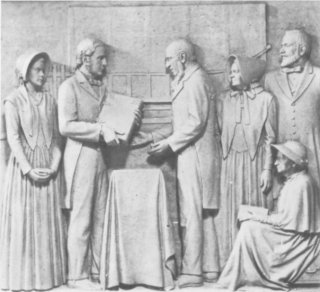
As a young man Koos Bybel trekked from Stellenbosch to Swellendam where he became a farmer and miller. His nickname arose from his deep religious convictions which he instilled into his family. In 1823 he moved to the Humansdorp area near Uitenhage and lived at the mouth of the Krom River with his son Piet Italeni. Although rarely referred to in history books he was, at 65 years of age, the nominal head of the Uys Trekker party. During the Trek his sage counsel prevailed when his sons wished to pursue marauders who had stolen horses from them. Whilst in the Cape, he reasoned, any punitive expeditions would be subject to British investigation and would not be worthwhile.
In October 1837 Koos Bybel had a mud and daub church built at 'Kerkspruyt' near Thaba 'Nchu and requested the Wesleyan missionary, James Archbell, to officiate at the first Holy Communion of the Trekkers held north of the Orange River. To commemorate the event he chiselled his name on a large rock, which is now housed at the Bloemfontein Museum.
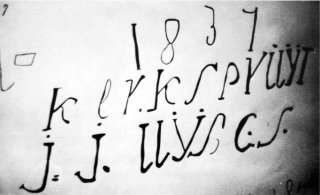
Koos Bybel died, aged 68, at Plessis Laager, near the present-day Pietermaritzburg, having reached his 'promised land'.
Piet Italeni, the famous Voortrekker leader, was a stocky blonde man with blue eyes. At 18 years of age he married his cousin, Alida Maria, and had three sons: Jacobus Johannes (Kruppel Koos 1819-1886), Dirk Cornelis (Dirkie 1823-1838) and Petrus Lafras (Piet Hlobane 1827-1879). He was a well-spoken, intelligent man whose personal friends included the Governor, Sir Benjamin D'Urban, and Colonel Harry Smith. His bravery in the Frontier raids led to his appointment as a spokesman and leader of the farmers at a young age.
'Pieter Uys was one of the best kind of man to be found in South Africa. He had not the advantage of a university training or even of a good school education, but he had the capacity of drawing information from every source within his reach, and putting it to the best use. He could write a letter or draw up a document in clear and concise Cape Dutch, and he was acquainted with what was going on overseas. His upright conduct, his religious convictions, and his kindly disposition caused him to be held in general esteem, not only by his Dutch-speaking neighbours, but by the English settlers of Albany, with whom he was brought into close contact during the Kaffir War of l835.'(12)
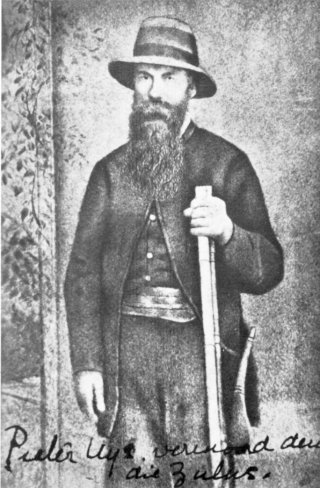
Correction published in a following Journal:
'Petrus Lafras (Piet Hlobane) 1827-1879'
There is no known photograph or likeness of
Piet Italeni - the painting is of his son.
Although Boer leaders were generally elderly men, at 37 years of age Piet was acknowledged as one of them. The answer may lie in the following quotation: 'Piet Lavras Uys was one of the finest types of men that ever walked the good earth of South Africa. He was fair and shaggy-bearded. Though quick-tempered, he was always fair and honourable in his treatment of others. A man of good education and brave as a lion, he was deeply respected by all who knew him . . '(15)
In September 1834 Piet led the successful 'Commission Trek' to Natal. There were four of the Uys family among the 21 persons in the expedition: Piet, 37, Cobus, 34, with his wife Gertruida Johanna, and Jannie, 15.
Piet first approached the Xhosa chiefs, Hintza and Faku, and requested land for settlement. He was advised to speak to their enemy, Dingaan, and possibly form a buffer settlement between themselves and their arch-enemies, the Zulu. On first sighting Natal Piet is reported to have exclaimed, 'Only heaven can be more beautiful!'(6)
The expedition visited the Port Natal (Durban) settlement where Piet sought the advice of Dick King and others. Jannie was so enamoured with the area that his party promptly dubbed him 'Jannie Port Natal'. There is no certainty as to whether Piet met Dingaan. Gustav Preller(2) records that Piet fell ill and that Jannie negotiated with Dingaan's indunas by shouting across the flooded Tugela river. The family tradition states that Piet and two men visited Dingaan at his kraal. The Zulu chief agreed to the Boers settling in Natal and that after their arrival he would sign a contract. In order to guarantee a peaceful settlement he insisted that a hostage be left with him. Jannie volunteered to remain.(13) Piet assured Dingaan that if a hair of his brother's head was harmed, he would personally lead the reprisal raid. On leaving, the party promptly changed Jannie's new nickname to 'Jannie Gyselaar' (hostage).
Jannie soon grew bored and began pining for his family. It is not known whether this influenced Dingaan, for 12 days after the departure of Piet's party Jannie was allowed to leave and rejoin them. In order to ensure that the boy was not harmed, indunas were instructed to run on either side of his horse and to taste any food before it was given to Jannie.
The party returned to Uitenhage in February 1835. As the sixth Frontier War had broken out Piet immediately joined his Commando. During April 1835 he served under Cmdt Linde of the First Division and thereafter under Cmdt Somerset. In September, Piet led a party of 22 burghers in a skirmish against 60 of Tyali's people who had stolen a herd of cattle. Piet sent a messenger to tell them that if they surrendered no harm would befall them. They promptly murdered the messenger. During the ensuing fight 18 of the enemy were killed and the looted cattle recaptured.(3)
On 26 October, whilst returning home, Piet was told at the Gamtoos River ferry that his wife, Alida, had been arrested the previous day on a charge of slapping a servant girl, Rosina. He immediately journeyed to Port Elizabeth to attend the trial. Although Alida was acquitted of the charge and Rosina was reprimanded for perjury, Piet was so incensed that he wrote to Sir Benjamin D'Urban and sued the Special Justice, Thomas Sherwin, for wrongful arrest. Events were moving swiftly and could not wait on this case coming to Court.(4)
Following the report of the Commission Trek, farmers were leaving on The Great Trek. Piet sold his farm in December 1836, and in April 1837 left Uitenhage with his party of 100 Trekkers. At Grahamstown the British settlers banded together and bought a large Bible which was presented to Koos Bybel and Piet 'as a farewell token of their esteem and heartfelt regret at their departure'.
Piet replied to the deputation of English friends and recent comrades in arms. 'He felt deep regret at parting with so many kind friends, but he hoped as long as they all remained on this side of the grave, although parted by distance, they should remain united in heart'.(5) A monument at Grahamstown in the shape of an open Bible commemorates this historic event.
On 29 June the Uys party reached the combined Trekker Laager at Sand river to discover that Piet Retief had been elected Governor. Piet refused to accept Retief's leadership or their draft constitution. He insisted that democratic elections would be held once Natal was reached and proposed a constitution based on that of the United States of America. In August Piet wrote to his friend Sir Benjamin D'Urban, setting out his reasons for leaving the colony. Whilst encamped at 'Kerkspruyt' Uys visited the Basuto chieftain, Moshesh, and requested permission to erect a more permanent church at their present encampment at some date in the future. On 19 October he concluded a friendly agreement with Maroko, the chief of the Barolongs, at Thaba'Nchu.
Piet then joined forces with Andries H. Potgieter to avenge the latter's defeat by the Matabele. A Commando of 322 mounted men crossed the Vaal River and harried the Matabele in many bloody battles in the Marico valley area (west of present Rustenburg). At eGabeni on 9 November the Matabele drove forward behind a herd of stampeding cattle, however the Trekkers managed to disperse the animals with well-placed volleys and drove them back on the enemy.
This campaign was the greatest single reason for the later peaceful settlement of the Highveld and has been grossly underrated in Southern Africa's history. Over 3 000 Matabele were killed and thousands of slaves set free. Msilikatse and his nation were driven beyond Botswana into Rhodesia, without the loss of a single man in the combined Trekker commando.
On their return to the Trekker laager Piet was incensed to find it empty. Retief had already left for Natal. Dr. Ransford writes 'One suspects as well that Retief was anxious to stake out his own people's claim to the best land in Natal before Piet Uys turned up with his turbulent followers.'(6)
Piet decided to reconnoitre and find out what the situation was in Natal before committing his family. He met and joined Andries Pretorius' party, then travelled with them to Retief's laager at Doornkop which they reached on 15 December. Piet was made to feel unwelcome. His abrupt manner and caustic comments caused a great deal of argument (opschudding)(7). The Retief faction attempted to coerce Piet into accepting Retief's leadership. It is highly unlikely that they succeeded in doing so, for shortly afterwards Piet returned to fetch his party.
The tragic events which followed in Natal have been well recorded; the traditional Uys family version of the reasons for the massacres have not. According to the Uys descendants, Dingaan confused Piet Retief with Piet Uys. The Zulu King assumed that 'UPiti' had changed himself by sorcery into another man, from a blonde to a redhead like a 'Nwabu' (Chameleon); thus his historic order 'Babulalani Abathakati' ('Seize them! Kill the Wizards').
Ransford records that when the news reached him 'Uys at Winburg responded at once and came riding down the Drakensberg passes with welcome reinforcements of men and ammunition. His intense pugnacious spirit was not so much responding to the Siren song of Natalland, as pulled now by a very real concern for the safety of his fellow countrymen. Uys was followed, with noticeably less enthusiasm, by Hendrik Potgieter'(6)
Piet was elected as the 'General Veldkommandant'. Potgieter objected to this and Piet thereupon agreed to share the command with him. The combined Commando of 347 men set off for Dingaan's kraal on 5 April 1838. The precise site of the ensuing Battle of Italeni is today a matter of dispute. In the author's opinion the most likely site is that pin-pointed by the Rev. H.C. de Wet i.e. approximately five kilometres SW of Dingaanstat in a narrow pass.
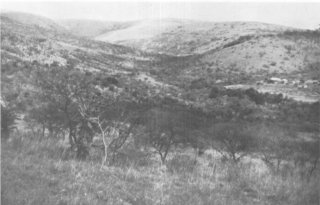
Approximately 7 500 Zulus awaited the Commando in this area, dispersed on the two hills flanking the valley, and hidden in the valley. Hendrik Potgieter chose to attack the left-hand hill. Piet left his brother Cobus in charge of the packhorses and attacked the right-hand hillock successfully. Potgieter's men made a half-hearted attack on the left then withdrew, allowing the Zulus to encircle Piet's force.
Two brothers, Johannes and Jacobus Malan who had ridden ahead of Piet's party were ambushed. Piet called for volunteers and rode to their rescue, leaving one of his party, Koos Potgieter, to concentrate the fire power and blast a way out of the encircling Zulu impis.
Piet reached the Malan brothers and was shepherding them back when a flung assegai caught him in the small of his back. His grey horse turned red as the blood pumped out of his back. He nevertheless retained his seat and rejoined his small party of volunteers. Piet begged them to leave him as he said that he was mortally wounded. This they refused to do and holding him upright began the retreat.
The Malan brothers were killed and shortly afterwards their father with Gert and Louis Nel were trapped in a donga - the last seen of them was their swinging rifle butts above the heads of the Zulus. These rifles were later retrieved at Dingaanstat and that of Louis Nel is at the Pietermaritzburg Voortrekker museum. On a number of occasions Piet fainted and fell off his horse. Each time his concerned followers revived him and brushed aside his protests to be left. Eventually, as the Zulus closed in they were compelled to do so.
The usual version of how Piet's son, Dirkie, 15, met his death is that on glancing backwards he saw his dying father lift his head for a last look at his son. The anguished boy turned his horse and with a cry of 'I will die with my father' he raced back to Piet, shooting three Zulus in the process, and fell under the assegais at his father's side.(9)
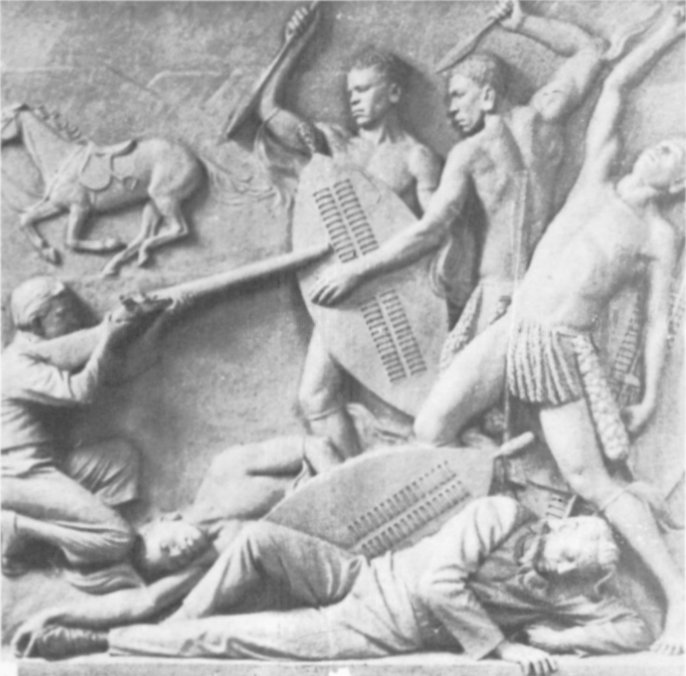
The Uys family version is that Dirkie was not aware of his father's fate. He and Jan de Jager, 20, were galloping together when Zulus sprang up in a reed-choked stream ahead. Jan's horse jumped in and out of the donga, but Dirkie's horse landed with its forelegs splayed and before he could escape Dirkie was dragged from its back. His remains were never found, possibly through being washed away in the donga. Another version is that he was taken alive to Dingaan who had 'muti' (medicine) made from this brave young boy.
The Commando returned to the laager in disgrace - to be labelled as 'Die Vlugkommando' (The Flight Commando). They had lost ten valuable men, including Piet, the only Voortrekker leader to die in battle. Hendrik Potgieter was much maligned and in disgust he and his followers left Natal.
The rest of the Voortrekker trials in Natal are well documented, culminating in the victorious Battle of Blood River. Piet's brother, Cobus, 38 was one of the four laager commandants. His brothers, Swart Dirk, 24, and Jannie Gyselaar, 19, together with his son Piet Hlobane, 11, and nephew Johannes Jacobus, 10, (son of Cobus) also fought at the famous battle. Jannie crept out of the laager during the thanksgiving prayers to retrieve a souvenir. A 'dead' Zulu sprang up as Jannie approached and they fled in opposite directions. Jannie arrived back in the laager before the prayer had ended.
Cobus was widowed and later moved to the Transvaal where he remarried. A son, Dirk Cornelius (1845-1926) was to serve as a member of the early Executive Council of Natal. His son, Petrus Lafras (1852-1924) who was born in the Transvaal was to serve as a member of the Transvaal Volksraad and as the commandant of the Pretoria-north Commando during the anglo Boer War. He was awarded the Dekoratie Voor Trouwe Dienst for his services. During the war Petrus's wife and six children were sent to the Middelburg concentration camp where his youngest daughter, Marthatjie, died. Petrus was one of the 60 Boers at the Peace Conference at Vereeniging.
Swart Dirk, who had his thumb blown off when his musket exploded at Italeni, lived to the ripe age of 96 years. In 1859 Swart Dirk surveyed a town, which he called Uysenburg, with an eland hide rope. This town was later to be called Marthinus Wesselstroom, and today Wakkerstroom. His fame as a cattle breeder is legendary, and he is known as the father of the Drakensberg race of cattle. They are today still known as the 'Uysbees' in certain quarters. Swart Dirk would not assist the British during the Zulu War of 1879, but made a good profit out of selling horses and provisions to them. His beautiful daughter, Sannie, and the young Prince Imperial of France were thought to be in love. The Prince was killed during a skirmish with Zulus in June 1879. During the Transvaal War of Independence he served on General Joubert's staff and was one of the signatories to the Peace Treaty at O'Neill's cottage.
On 28 January, 1881, Swart Dirk's son, Dirk Cornelius, 25, was killed at the Battle of Laings Nek. On 8 March his family joined the main Boer laager at Majuba. Swart Dirk's daughter, Sannie, played and sang to the Boers during the week she remained there. The hard-bitten men loved her for her beauty and lilting voice, which reminded them of home and loved ones.(14) This is possibly the earliest recorded entertainment of Boer troops by their own people whilst on active service in South Africa. Swart Dirk spent most of the (1899-1902) Boer War in a concentration camp, much to his disgust. When released he immediately excavated the gold Kruger sovereigns which he had buried, and started afresh.
Wessel married the daughter of Louis Nel, who was killed at Italeni. His son Jacobus Johannes (Kootjie) (1858-1942) served as a senator in the early Union Parliament. Wessel settled near Richmond in Natal. He was a large man, known for his bravery and particularly remembered for chasing an armed Zulu on horse-back and knocking him out with the butt end of his horsewhip.
Piet Italeni's remaining two sons were also to feature prominently in the years ahead. Kruppel Koos, though the oldest, had been crippled in a wagon accident as a boy and therefore saw no military service. He is reputed to have collected his father's remains at Italeni for reburial. Alida remarried Andries Theodorus Spies, who disinherited Piet's sons. Kruppel Koos thereafter raised his young brother Piet Hlobane in his own home.
When Sir Harry Smith visited Natal Koos appealed to him, as his late father's friend, for assistance. This was granted and the two boys were given land in the Klip River (Ladysmith) district. Kruppel Koos visited Lord Chelmsford at Rorkes Drift in early January 1879 and cautioned him against over-confidence. The English would only succeed against the Zulus if they fought in the Boer manner from behind cover. The General ignored this advice and met with the disaster at Isandhlwana.
Piet Hlobane served as a member of the Natal Volksraad until he was widowed. He thereafter devoted himself to his family alone. He was 52 years old when the Zulu War of 1879 broke out. He immediately raised and provisioned his own Corps to serve with Woods's column. He refused any compensation for damages, or salaries for his men as this would further alienate him from his countrymen, who were against the voluntary service with the British following the annexation of the Transvaal.
Piet Hlobane wished to avenge his father's death but not at the expense of his four sons, about whom he was
very concerned:
Petrus Lafras (Vaal Piet 1851-1926),
Cornelis Lucas (Bloustroom 1857-1941),
Jacobus Johannes (1863-1913)
and Dirk Cornelis (Dirks 1865-1899).
Piet was killed at the Battle of Hlobane Mountain on 28 March 1879, when he returned to Devils Pass to assist Vaal Piet who was struggling to lead two horses.(10) It is incongruous that neither he nor his sons have been granted the Zulu War campaign medal as they were not on the payrolls! The descendants' claims for these medals have been refused by the War Office.
Vaal Piet served as a Commandant during the Boer War and was present when his son Petrus Lafras, captured a British maxim gun at Talana. They were both captured later and imprisoned at St. Helena.
Bloustroom was a 'bitter-einder', having fought until the end of the war. His sons served with Collins's Scouts in South-West Africa during the First World War. A grandson, Dirk Uys Nel, was to win the DFC in the Warsaw Air Lift during the Second World War.
Young Dirk, who was only 14 when he fought at Hlobane, was to be credited by some the following year as the Boer who shot General Colley at Majuba(11). He was killed by a shell at Talana during the Boer War aged 34. His son is at present living at the Volksrust old age home.
Although the descendants of Koos Bybel may appear to have been extremely martial, the circumstances of the time dictated their actions. They lived by the teachings of the Bible and were ever-ready to fight for their beliefs. It is men like these who have shaped history throughout the ages.
Addendum – SAMHS Journal December 1976 Article entitled 'A Boer Family' by Ian Uys
As a past president of the Society I wish to update the above article, which is available on your website. At the time I wrote, "The precise site of the ensuing Battle of Italeni is today a matter of dispute. In the author's opinion the most likely site is that pin-pointed by the Rev H C de Wet i.e. approximately four kilometres south-west of Dingaanstat in a narrow pass." In October 2014 a local farmer in the Melmoth area - and fellow Society member - Paul Smith, revisited the site with me. He pointed out that the site was on the Nzololo Stream, a tributary of the Mkumbane River. This site is south-west of Dingaanstat at the farm Doornkloof (the coordinates are 28°23'19" and 31°17'08" E). The terrain matched the description of Cmdt Piet Uys and Hendrik Potgieter attacking the Zulu impis on adjoining hills. A local Zulu woman resident in the valley told us that we were on the ancient route to Umgungundlovu, Dingaan's kraal, and that her father had informed her of the battle which had taken place there according to their ancestors.
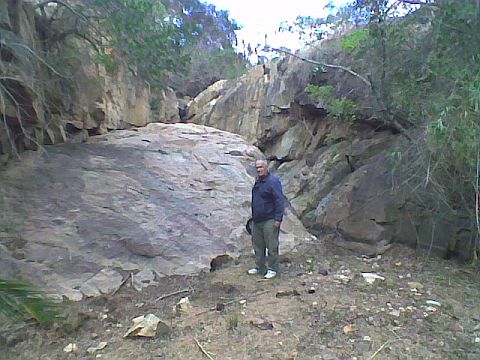
Then Paul pointed out the graves of six of the Trekkers who were killed. Further up the Nzololo Stream we came across the Rock barrier (per above photo) which the fleeing Trekker party had to bypass. At that site a small stirrup was found by a local, which had probably belonged to Dirkie Uys, 15. Further up the ridge he pointed out the likely site of Dirkie's grave. While this addition comes almost 40 years late, a policy of 'better late than never' is surely acceptable. It could be of great historical value if the local KwaZulu authorities exhumed the graves and did a display of the relics at the Dingaanstat Museum nearby. As this is one of the few Zulu victories against the Trekkers there should be no objection thereto!
Yours faithfully,
Ian S Uys
fortress@iafrica.com
044 382 6805
PO Box 6475,
Knysna
6570
Return to Journal Index OR Society's Home page
South African Military History Society / scribe@samilitaryhistory.org